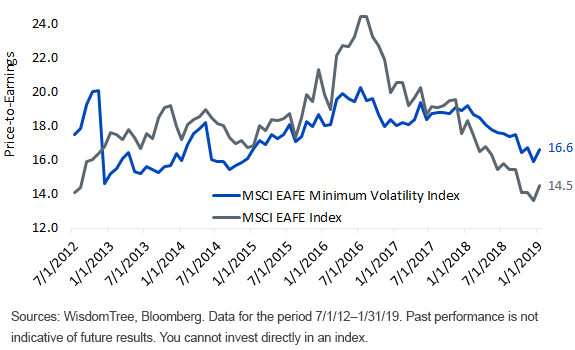The Minimum-Volatility Phenomenon
Exchange-traded fund (ETF) flows can be a good indicator of investor sentiment.
So far this year, sentiment toward developed international equities has been tempered—of the top 30 flow gatherers, none are focused on this segment of the market.1
But in developed markets broadly, both the U.S. and internationally, there has been significant movement into funds that target minimum volatility.
With so much demand for holdings that exhibit lower historical volatility, what exactly are the characteristics of these stocks?
Let’s focus on the developed international universe, where the most compelling case for that market seems to come down to favorable valuations.
Watch the Price Tag
Basic finance theory tells us that a riskier basket of stocks should command a greater equity risk premium than a less volatile basket. Thus, it makes sense that a minimum volatility index would trade at a premium to the broader market.
We can test this theory by looking at the valuations of the MSCI EAFE Index and the MSCI EAFE Minimum Volatility (USD) Index. Going back to 2012, the valuation gap between the two indexes has oscillated between premium and discount. Oddly enough, investors have often gotten away with not paying a premium for lower-vol stocks.
Why? In part because those stocks have at times been discounted since they are over-weight in sectors with lower growth expectations, such as Utilities and Real Estate.
Today’s nearly 15% multiple premium for the min-vol index is near the most expensive valuation gap over the past five years. At these elevated valuations, investors modeling long-term returns based on this min-vol index need to dampen return expectations relative to the broader index.
Developed International Price-to-Earnings Over Time

Looking for Quality?
Min-vol indexes tend to have greater exposure to profitable companies, which explains in part the high correlation between the min-vol and quality factors. The loading to quality is evident from the table below that shows factor loadings across the Fama-French five-factor model. The trade-off for a 0.53 loading to quality is the -0.30 loading to value.
This has been an understandable trade-off of value and quality over time: a higher-quality basket comes at a higher cost.
Value-Quality Trade-off

In addition to the returns-based regression, we have sorted the MSCI EAFE Index universe of stocks into volatility quintiles going back to 2002. Interestingly, the lowest-vol quintile has actually been less expensive than the market—a median price-to-earnings ratio (P/E) of 14.3x for the low vol quintile compared with 15.5x for the MSCI EAFE Index.
In addition to being historically less expensive, the lowest vol quintile typically has had a significantly higher return on equity (ROE) than the MSCI EAFE Index.

Today, the characteristics are reversed. The P/E ratio of the low-vol quintile is at a premium to the MSCI EAFE Index, with a lower-quality basket of stocks as measured by ROE.
This prompts two questions: With all the interest in min-vol, are the prices justified by lower-quality characteristics than the market? And second, is there a way to tap into developed international equities with an eye toward a more balanced factor exposure?
The WisdomTree International Multifactor Fund (DWMF) has had remarkably similar volatility as the MSCI EAFE Minimum Volatility Index since its inception in August 2018.2 However, this performance has been achieved with a portfolio that is presently at a discount to the MSCI EAFE Index on a P/E basis and with higher quality as measured by ROE.3
We will drill in deeper on these points in subsequent posts.
1Source: WisdomTree, for the period 1/1/19–2/28/19.
2Sources: WisdomTree, FactSet. Returns for the period 8/10/18–2/28/19.
3Sources: WisdomTree, FactSet, as of 2/28/19.
Disclaimer: Investors should carefully consider the investment objectives, risks, charges and expenses of the Funds before investing. U.S. investors only: To obtain a prospectus containing this ...
more


